Big Ideas Math Integrated Math Chapter 4 Maintaining Mathematical Proficiency
Page 90 Exercise 1 Problem 1
Question 1.
Given the graph below, identify the coordinates of point A.
- Determine the x-coordinate of point A by finding the perpendicular distance from the y-axis.
- Determine the y-coordinate of point A by finding the perpendicular distance from the x-axis.
- Write the ordered pair that corresponds to point A.
Answer:
we will find the x-coordinate of a point & the y-coordinate of a point by getting perpendicular distances from the axis.
Point A

The x-coordinate of A: 2
The y-coordinate of A: 6
The ordered pair corresponds to point A is (2,6)
The ordered pair corresponds to point A is (2,6)
Page 90 Exercise 2 Problem 2
Question 2.
Given the graph below, identify the coordinates of point E.
- Determine the x-coordinate of point E by finding the perpendicular distance from the y-axis.
- Determine the y-coordinate of point E by finding the perpendicular distance from the x-axis.
- Write the ordered pair that corresponds to point E.
Answer:
We will find the x-coordinate of a point & the y-coordinate of a point by getting perpendicular distances from the axis.
point E
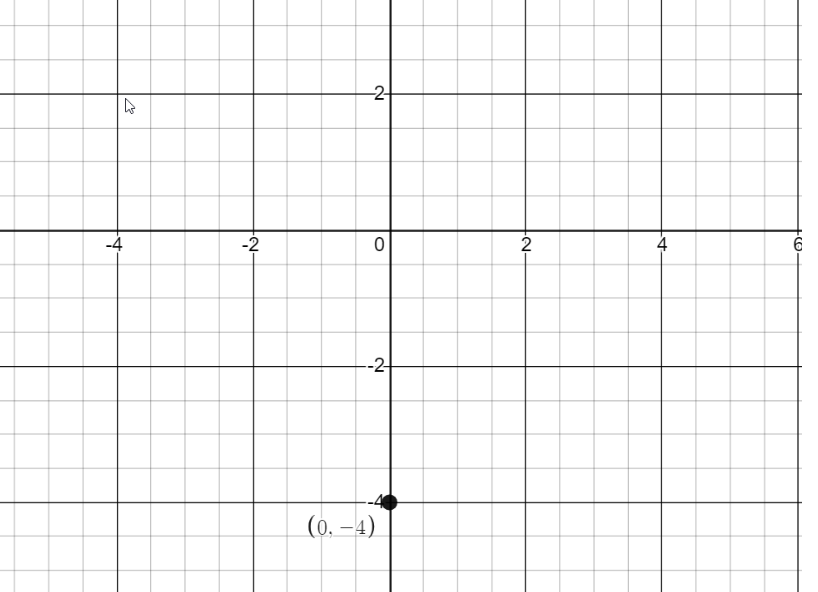
The x-coordinate of E: 0
The y-coordinate of E: − 4
The ordered pair corresponds to point E is (0,−4)
The ordered pair corresponds to point E is (0,−4)
Page 90 Exercise 3 Problem 3
Question 3.
Given the graph below, identify which points are located in Quadrant III of the Cartesian coordinate system.
- List all the points from the graph.
- Determine which points are located in Quadrant III.
- Write the coordinates of the point(s) that are located in Quadrant III.
Answer:
Cartesian coordinates system
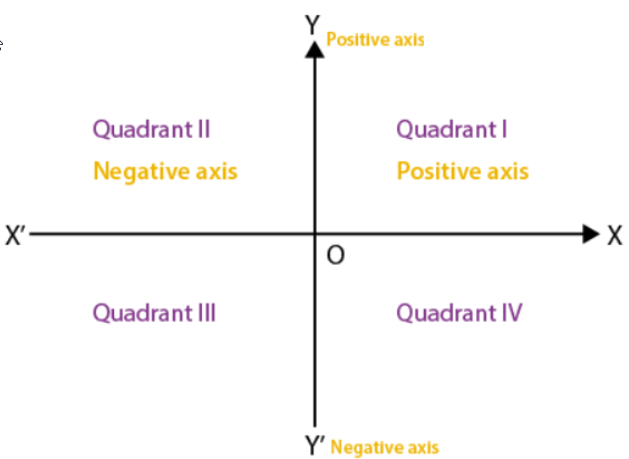
We will check which points in the given graph is in Quadrant III
Points in III Quadrant
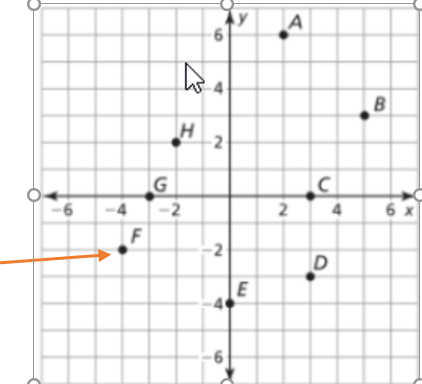
F is only in III Quadrant
F is only in III Quadrant
Page 90 Exercise 4 Problem 4
Question 4.
Given the graph below, identify which points are located in Quadrant IV of the Cartesian coordinate system.
- List all the points from the graph.
- Determine which points are located in Quadrant IV.
- Write the coordinates of the point(s) that are located in Quadrant IV.
Answer:
Cartesian coordinates system

We will check which points in the given graph is in Quadrant IV
Points in IV Quadrant
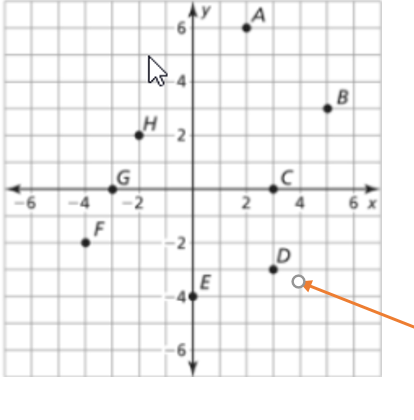
D is only in IV Quadrant
D is only in IV Quadrant
Page 90 Exercise 5 Problem 5
Question 5.
Given the graph below, identify which points are located on the negative x-axis of the Cartesian coordinate system.
- List all the points from the graph.
- Determine which points are located on the negative x-axis.
- Write the coordinates of the point(s) that are located on the negative x-axis.
Answer:
Cartesian coordinates system

We will check which points are located on the negative x-axis
Points are located on the negative x-axis

G is the only point located on the negative x-axis
G is the only point located on the negative x-axis
Page 90 Exercise 6 Problem 6
Question 6.
Solve the equation x – y = -12 for the variable y.
Answer:
Given
x − y = −12
By using the isolation of variable y of the given equation, we will solve the equation for y.
x−y = −12
Subtracting x to both sides
x − y − x = −12−x
−y = − 12− x
Dividing by -1 on both sides
y = 12 + x
Solution of x − y = −12 for y = 12 + x
Page 90 Exercise 7 Problem 7
Question 7.
Solve the equation 8x + 4y = 16 for the variable y.
Answer:
Given
8x + 4y = 16
By using the isolation of variable y of the given equation, we will solve the equation for y.
8x + 4y = 16
Dividing by 4 on both sides
\(\frac{8x+4y}{4}=\frac{16}{4}\)2x + y = 4
Subtracting 2x from both sides
2x + y −2x = 4 − 2x
y = 4 − 2x
Solution of 8x + 4y = 16 for y = 4 − 2x
Page 90 Exercise 8 Problem 8
Question 8.
Solve the equation 3x – 5y + 15 = 0 for the variable y.
Answer:
Given
3x−5y + 15 = 0
By using the isolation of variable y of the given equation, we will solve the equation for y.
3x − 5y + 15 = 0
Adding 5y on both sides
3x − 5y + 15 + 5y = 0 + 5y
3x + 15 = 5y
Dividing by 5 on both sides
\(\frac{3x+15}{5}\)= y
Interchanging both sides
y = \(\frac{3x+15}{5}\)
Solution of 3x−5y+15=0 for y = \(\frac{3x+15}{5}\)
Page 90 Exercise 9 Problem 9
Question 9.
Solve the equation 0 = 3y – 6x + 12 for the variable y.
Answer:
Given
0 = 3y−6x+12
By using the isolation of variable y of the given equation, we will solve the equation for y.
0 = 3y − 6x + 12
Subtracting 3y from both sides
0 − 3y = 3y − 6x + 12 − 3y
−3y = −6x + 12
Dividing by −3 both sides
\(\frac{−3y}{−3}\)=\(\frac{−6x+12}{−3}\)
y = 2x − 4
Solution of 0 = 3y − 6x + 12 for y = 2x − 4
Page 91 Exercise 10 Problem 10
Question 10.
Given two points (0,-1) and (2,3) on a graph, find the slope of the line passing through these points. Using the slope and one of the points, determine the y-intercept and write the equation of the line. Finally, plot the line and identify its slope and y-intercept.
Answer:
Given
(0,-1) and (2,3)
From the given graph, we can find the slope of the line where 2 points are known using slope & given point we will find both intercept of line
The slope of the line from points (0,−1) & (2,3)
m = \(\frac{−1−3}{0−2}\)
m = 2
y = 2x + c
Putting point (2,3) in the equation
3 = 2 × 2 + c
c = −1
Equation of line y = 2x − 1
Plot
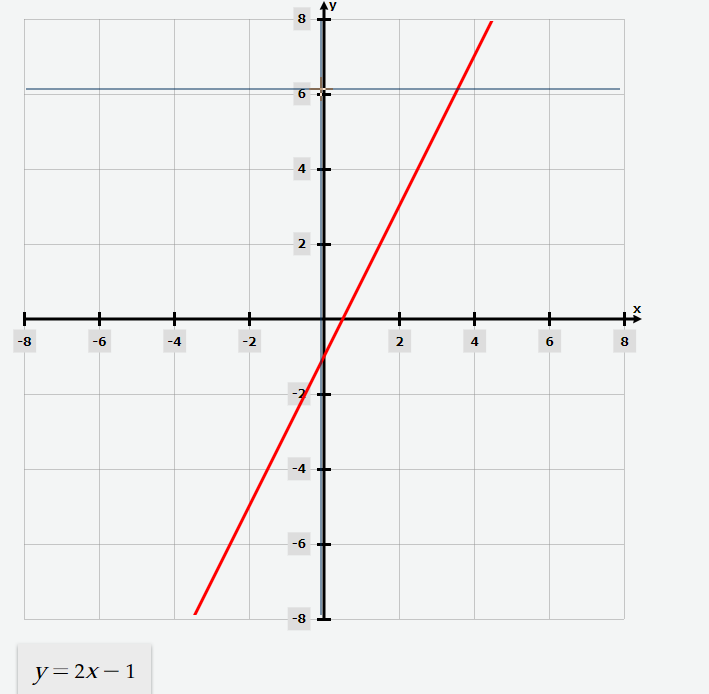
y-Interceptc = −1 , Slope m = 2, Liney = 2x−1
Page 91 Exercise 10 Problem 11
Question 11.
Given two points (0,2) and (4,-2) on a graph, find the slope of the line passing through these points. Using the slope and one of the points, determine the y-intercept and write the equation of the line. Finally, plot the line and identify its slope and y-intercept.
Answer:
Given
(0,2) and (4,-2)
From the given graph, we can find the slope of the line where 2 points(0,2)&(4,−2) are known using slope & given point we will find both intercepts of the line
The slope of the line from points (0,2) & (4,−2)
m = \(\frac{−2−2}{4−0}\)
m = −1
y = −x + c
Putting point(0,2) in the equation
2 = 0 + c
c = 2
Equation of line y = −x + 2
Plot
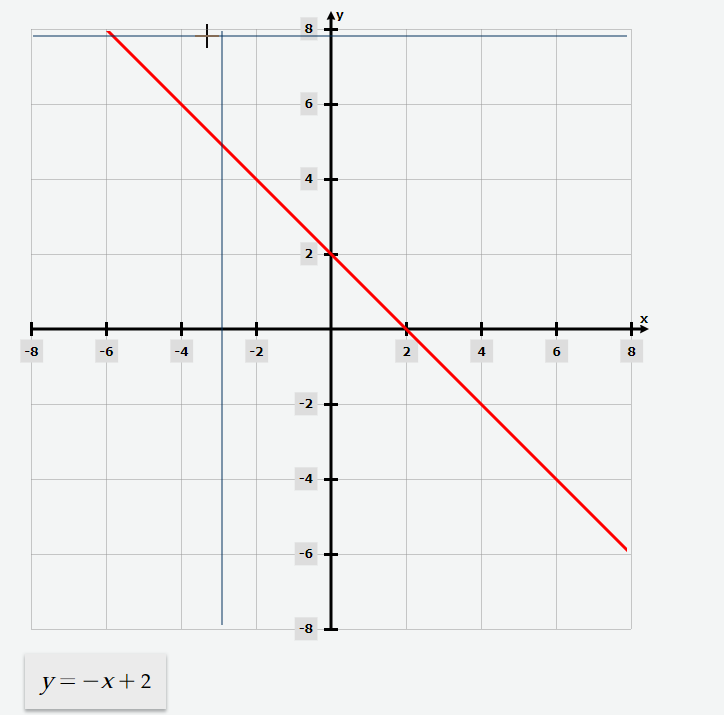
y-Intercept c = 2 , Slope m = −1, Line y = −x + 2
Page 91 Exercise 10 Problem 12
Question 12.
Given two points (−3,3) and (3,−1) on a graph, find the slope of the line passing through these points. Using the slope and one of the points, determine the y-intercept and write the equation of the line. Finally, plot the line and identify its slope and y-intercept.
Answer:
Given
(−3,3) and (3,−1)
From the given graph, we can find the slope of the line where 2 points (−3,3) & (3,−1)are known using slope & given point we will find both intercept of line
The slope of the line from points (−3,3)&(3,−1)
m = \(\frac{−1−3}{3+3}\)
m = \(\frac{−4}{6}\)
m = \(\frac{−2}{3}\)
y= \(\frac{−2}{3}\) x + c
From(3,−1)
−1 = \(\frac{−2}{3}\) (3) + c
Cancellation to 3
−1= −2+c
c = 2−1
c = 1
y = \(\frac{−2}{3}\)x+1
Plot
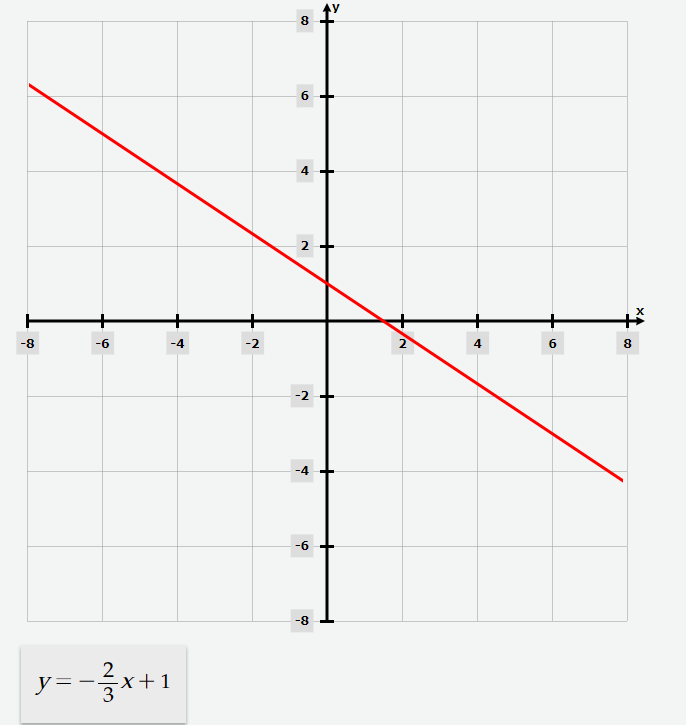
y-Intercept c=1, Slope m = \(\frac{−2}{3}\), Line y = \(\frac{−2}{3}\) x + 1
Page 91 Exercise 10 Problem 13
Question 13.
Given two points (4,0) and (2,−1) on a graph, find the slope of the line passing through these points. Using the slope and one of the points, determine the y-intercept and write the equation of the line. Finally, plot the line and identify its slope and y-intercept.
Answer:
Given
(4,0) and (2,−1)
From the given graph, we can find the slope of the line where 2 points(4,0)&(2,−1) are known using slope and given point we will find both intercepts of line
The slope of the line from points (4,0) & (2,−1)
Slope m = \(\frac{−1−0}{2−4}\)
m = \(\frac{1}{2}\)
y=\(\frac{1}{2}\)x + c
From point (4,0)
0 = \(\frac{1}{2}\)(4) + c
c = −2
y = \(\frac{x}{2}\) − 2
Plot
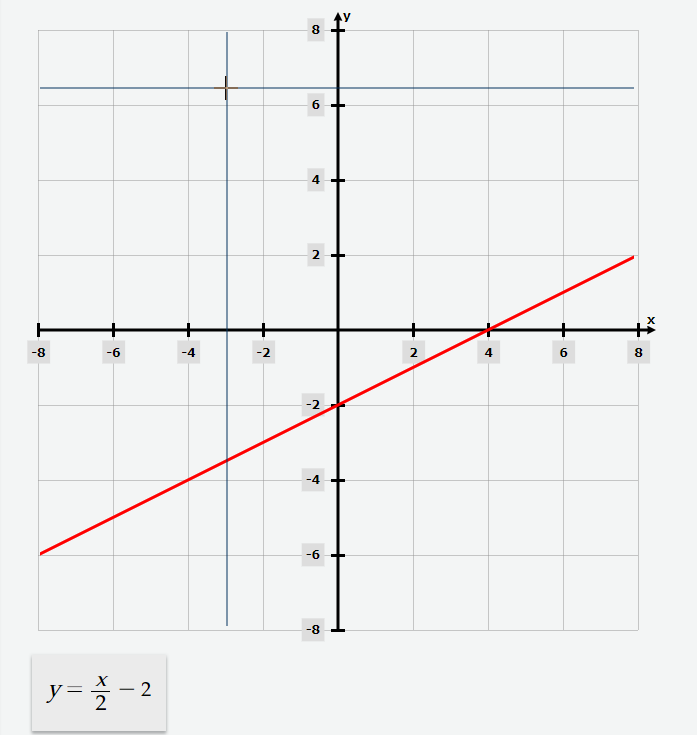
y-Intercept c = −2, Slope m = \(\frac{1}{2}\), Line y = \(\frac{x}{2}\) − 2
Page 92 Exercise 11 Problem 14
Question 14.
Given two points (0,20) and (2000,80) on a graph, find the slope of the line passing through these points. Using the slope and one of the points, determine the y-intercept and write the equation of the line.
Answer:
Given
(0,20) and (2000,80)
From the given graph, we can find the slope of the line where 2 points (0,20) & (2000,80)are known using slope & given point we will find both intercepts of line
The slope of the line from points (0,20) & (2000,80)
m = \(\frac{3}{100}\)
y-Intercept
c = 20
Using these
y = \(\frac{3}{100}\) x+20
Equation of a given line y = \(\frac{3}{100}\) x+20
Page 94 Exercise 12 Problem 15
Question 15.
Find the equation of a line given its slope m = 2 and y-intercept c = −3
Answer:
Given
m = 2 and y-intercept c = −3
Using slope & y-intercept we will find the equation of the line
y = mx + c
Putting m & c values
y = 2x − 3
Equation of the line y = 2x − 3
Page 94 Exercise 12 problem 16
Question 16.
Find the equation of a line given its slope m = −3 and y-intercept c = 7.
Answer:
Given
m = −3 and y-intercept c = 7.
Using slope & y-intercept we will find the equation of the line
y = mx + c
Putting m & c values
y =−3x + 7
Equation of the line y = −3x + 7
Page 94 Exercise 13 Problem 17
Question 17.
Find the equation of a line given its slope \(m = /frac{1}{3}\) and y-intecept c = 2.
Answer:
Given
\(m = /frac{1}{3}\) and y-intecept c = 2.
Using slope & y-intercept we will find the equation of the line
y = mx + c
Putting m & c values
y = \(\frac{1}{3}\) x + 2
Equation of the line y = \(\frac{1}{3}\) x + 2
Page 94 Exercise 14 Problem 18
Question 18.
Given two points (0,0) and (2,4) on a graph, find the slope of the line passing through these points. Using the slope and one of the points, determine the y-intercept and write the equation of the line.
Answer:
We will get the slope from the given points & put the slope value in the line equation.
By using the known slope equation we use one point to get the value of y-intercept by satisfying that point
Given points (0,0) & (2,4)
Slope m = \(\frac{4−0}{2−0}\)
m = 2
y = 2x + c
Using (0,0)
c = 0
y = 2x
Equation of the line in slope-intercept form y = 2x
Page 94 Exercise 15 Problem 19
Question 19.
Given two points (0,5) and (3,−4) on a graph, find the slope of the line passing through these points. Using the slope and one of the points, determine the y-intercept and write the equation of the line.
Answer:
We will get the slope from the given points & put the slope value in the line equation.
By using the known slope equation we use one point to get the value of y-intercept by satisfying that point
Given points (0,5) & (3,-4)
Slope m = \(\frac{−4−5}{3−0}\)
m = −3
y = −3x + c
Using point (0,5)
5 = 0 + c
c = 5
y = −3x + 5
Equation of the line in the slope-intercept form y = −3x + 5
Page 94 Exercise 16 Problem 20
Question 20.
Given two points (−2,−3) and (0,−2) on a graph, find the slope of the line passing through these points. Using the slope and one of the points, determine the y-intercept and write the equation of the line.
Answer:
We will get the slope from the given points & put the slope value in the line equation.
By using the known slope equation we use one point to get the value of y-intercept by satisfying that point
Given points(-2,-3) & (0,-2)
Slope m = \(\frac{−2+3}{0+2}\)
m = \(\frac{1}{2}\)
y = \(\frac{1}{2}\)x + c
Using point (0,-2)
c = −2
y = \(\frac{1}{2}\) x−2
Equation of the line in slope-intercept form y = \(\frac{1}{2}\) x−2
Page 94 Exercise 17 Problem 21
Question 21.
Given two points (0,3) and (4,0) on a graph, find the slope of the line passing through these points. Using the slope and one of the points, determine the y-intercept and write the equation of the line.
Answer:
We will get the slope from the given points & put the slope value in the line equation.
By using the known slope equation we use one point to get the value of y-intercept by satisfying that point
Given points (0,3) & (4,0)
Slope m = \(\frac{−3}{4}\)
y = \(\frac{−3}{4}\)x+c
Using (0,3)
c = 3
y = \(\frac{−3}{4}\) x + 3
Equation of the line in slope-intercept form y = \(\frac{−3}{4}\) x + 3
Page 95 Exercise 18 Problem 22
Question 22.
Given two points (2,1) and (0,−7) on a graph, find the slope of the line passing through these points. Using the slope and one of the points, determine the y-intercept and write the equation of the line.
Answer:
We will get the slope from the given points & put the slope value in the line equation.
By using the known slope equation we use one point to get the value of the y-intercept by satisfying that point
Given points (2,1) & (0,-7)
Slope m = \(\frac{−7−1}{0−2}\)
m = \(\frac{−8}{−2}\)
m = 4
y = 4x+c
Using point (0,-7)
c = −7
y = 4x − 7
Equation of the line in slope-intercept form y = 4x − 7
Page 95 Exercise 19 Problem 23
Question 23.
Given two points (0,2) and (4,3) on a graph, find the slope of the line passing through these points. Using the slope and one of the points, determine the y-intercept and write the equation of the line.
Answer:
We will get the slope from the given points & put the slope value in the line equation.
By using the known slope equation we use one point to get the value of y-intercept by satisfying that point
Given points (0,2) & (4,3)
Slope m = \(\frac{3−2}{4}\)
m = \(\frac{1}{4}\)
y = \(\frac{1}{4}\)x + c
Using point (0,2)
c = 2
y= \(\frac{1}{4}\) x+2
Equation of the line in slope-intercept form y = \(\frac{1}{4}\) x + 2
Page 95 Exercise 20 Problem 24
Question 24.
Given two points (8,0) and (0,8) on a graph, find the slope of the line passing through these points. Using the slope and one of the points, determine the y-intercept and write the equation of the line.
Answer:
We will get the slope from the given points & put the slope value in the line equation.
By using the known slope equation we use one point to get the value of the y-intercept by satisfying that point
Given points (8,0) & (0,8)
Slope m = \(\frac{−8}{8}\)
m = −1
y = −x + c
Using (0,8)
c = 8
y = −x + 8
Equation of the line in slope-intercept form y = −x + 8
Page 95 Exercise 21 Problem 25
Question 25.
Given two points (0,3) and (2,−5) on a graph, find the slope of the line passing through these points. Using the slope and one of the points, determine the y-intercept and write the equation of the line.
Answer:
We will get the slope from the given points & put the slope value in the line equation.
By using the known slope equation we use one point to get the value of y-intercept by satisfying that point
Given points (0,3) & (2,-5)
Slope m = \(\frac{−5−3}{2−0}\)
m = −4
y = −4x + c
Using point (0,3)
c = 3
y = −4x + 3
Equation of the line in the slope-intercept form y = −4x + 3
Page 95 Exercise 22 Problem 26
Question 26.
Given the linear function f(x)= c + dx and the following conditions:
- f(0) = 5
- f(9) = -4
Determine the values of the constants c and d. Write the final equation of the linear function.
Answer:
We will put given conditions in the linear function by which we will get values of constants (c,d)
f(x) = c + dx
Given f(0) = 5
f(0) = c
c = 5
f (9) = c + 9d
−4 = 5 + 9d
d = \(\frac{−9}{9}\)
d = −1
f(x) = 5 − x
A linear function f with the given values, f(x) = 5 − x
Page 95 Exercise 23 Problem 27
Question 27.
Given the linear function f(x)= c + dx and the following conditions:
- f(0) = 10
- f(7) = -4
Determine the values of the constants c and d. Write the final equation of the linear function.
Answer:
We will put given conditions in the linear function by which we will get values of constants (c,d)
Given f(0) = 10
f(0) = c
c = 10
f(7) = c + 7d
−4 = 10 + 7d
d = \(\frac{−14}{7}\)
d = −2
f(x) = 10−2x
A linear function f with the given values f(x) = 10 − 2x
Page 95 Exercise 24 Problem 28
Question 28.
Given the linear function f(x)= c + dx and the following conditions:
- f(0) = 2
- f(-2) = -2
Determine the values of the constants c and d. Write the final equation of the linear function.
Answer:
We will put given conditions in the linear function by which we will get values of constants (c,d)
f(x) = c + dx
Given f(0) = 2
f(0) = c
c = 2
f(−2) = c−2d
−2 = 2 −2d
d = \(\frac{−4}{−2}\)
d = 2
f(x) = 2 + 2d
A linear function f with the given values f(x) = 2 + 2d
Page 95 Exercise 25 Problem 29
Question 29.
An electrician charges a fixed initial fee and an hourly rate for their services. The total cost function f(x) is given by f(x)=c+dx, where x is the number of hours worked.
Given the following conditions:
- The initial fee (when x=0) is 50.
- After 4 hours of work, the total cost is 190.
Determine the values of the constants c and d. Write the final linear model that represents the total cost as a function of the number of hours worked.
Answer:
f(x) = c + dx in this f(x) is electrician charges function of hours of work x
We will put given conditions in the linear function f(x) = c + dx by which we will get values of constants (c,d)
f(x) = c + dx , At x = 0 initially
f(0) = c
50 = c
After 4 hours of work
f(4) = c + 4d
190 = 50 + 4d
4d = 140
d = 35
f(x) = 50 + 35x
A linear model that represents the total cost as a function of the number of hours worked. f(x) = 50 + 35x
Page 95 Exercise 25 Problem 30
Question 30.
An electrician charges a fixed initial fee and an hourly rate for their services. The total cost function f(x) is given by f(x)= 50 + 35x, where x is the number of hours worked.
- Identify the slope (or gradient) of the linear function.
- Determine the electrician’s charge per hour.
Answer:
In the function that we find d is the charges per hour which is the gradient(slope) of the linear function
Linear model
In this slope or gradient is 35
The electrician charge per hour = 35
The electrician charge per hour = 35
Page 96 Exercise 26 Problem 31
Question 31.
Given the slope m and a point (x1,y1) through which a line passes, use the point-slope form of the equation of a line to find the equation of the line.
- The slope m=4
- The point (x1,y1) = (2,3)
Write the equation of the line using the point-slope form y −y1 =m(x−x1).
Answer:
Given slope & point, we will put them in the equation of the line when one point & slope is given
y − y1 = m(x−x1) by putting slope & one point values in this equation we get the equation of line
Equation of line when slope & one point is given y−y1 = m(x−x1)
Page 96 Exercise 27 Problem 32
Question 32.
Given the slope m and a point (x1,y1) through which a line passes, use the point-slope form of the equation of a line to find the equation of the line.
- The slope m = \(\frac{1}{2}\)
- The point (x1,y1) = (3,2)
Answer:
The slope is given & from the given graph we will get the points & use them to find the equation by putting them in the slope-point form of the equation
Slope m = \(\frac{1}{2}\)
Given point (3,2)
Using the slop-point form of the equation
y−y1 = m(x−x1)
y−2 = \(\frac{1}{2}\) (x−3)
Simplifying 2y − 4 = x−3
2y = x + 1
Equation of the line 2y = x + 1
Page 96 Exercise 28 Problem 33
Question 33.
Given the slope m=−2 and a point (−4,6) through which the line passes, use the point-slope form of the equation of a line to find the equation of the line. Then simplify the equation to the standard form.
Answer:
The slope is given & from the given graph we will get the point & use them to find equation by putting them in the slope-point form of equation
Slope m =−2
Given point (-4,6) using the slop-point form of the equation
y−y1 = m(x−x1)
y−6 = −2(x + 4)
Simplifying
y−6 = −2x−8
y + 2x + 2 = 0
Equation of the line y + 2x + 2 = 0
Page 96 Exercise 29 Problem 34
Question 34.
Given the slope m and a point (x1,y1) through which the line passes, use the point-slope form of the equation of a line to find the equation of the line.
- Find the equation of the line given the following conditions:
- Slope: m = 3
- Point: (2,−1)
- Find the equation of the line given the following conditions:
- Slope: m = \(-\frac{1}{2}\)
- Point: (4,5)
Answer:
The slope is given & from the given graph we will get the point & use them to find equation by putting them in the slope-point form of equatio
Slope is m
Given point (x1,y1)
Equation of the line when one point & slope is given
y − y1 = m(x−x1)
Equation of the line y−y1 = m(x − x1)
Page 97 Exercise 30 Problem 35
Question 35.
Given the slope m=25 representing the savings rate in dollars per month and a point (4,175) representing the savings after 4 months, use the point-slope form of the equation to find the equation of the line that models the savings over time.
- Write a point-slope from the equation y – y1 = m(x-x1) using the given slope and points
- Simplify the equation to the slope-intercept form.
Answer:
The slope is given & from the given graph we will get the point & use them to find equation by putting them in the slope-point form of equation
Given slope gradient of saving is $25 / month
m = 25
Given point (4,175)
y−y1= m(x−x1)
y−175 = 25(x−4)
Simplifying
y − 175 = 25x−100
y = 25x + 75
where y is saving & x is number of months
The equation that represents the balance A after x months. y = 25x + 75
Page 97 Exercise 30 Problem 36
Question 36.
Given the slope m=4 and the y-intercept 175, find the equation of the line in slope-intercept form and plot it on a graph to verify if it matches the given Plot.
Answer:
The slope is given & from the given graph we will get the point & use them to find the equation by putting them in the slope-point form of the equation.
We will plot equation on the graph & match with given plot
y = 4x + 175
Plotted graph is same as given
Page 97 Exercise 31 Problem 37
Question 37. Given the slope
m = 3 and a y-intercept = 175, use the slope-intercept form of the equation to find the equation of the line that models the given scenario.
- Identify the slope and y-intercept:
- Given: m = 4
- y-intercept = 175
- Write the slope-intercept form of the equation y = mx + b using the given slope and y-intercept.
- Plot the equation on a graph and verify if it matches the given plot.
Answer:
The slope is given & from the given graph we will get the point & use them to find equation by putting them in the slope-point form of equation.
y−y1 = m(x−x1) by putting slope & one point values in this equation we get the equation of line
Equation of line when slope & one point is given y−y1 = m(x−x1)
Page 97 Exercise 31 Problem 38
Question 38.
Given the slope m = 5 and a point (0,0) which is the origin, use the point-slope form of the equation to find the equation of the line.
- Identify the slope and point:
- Given: m = 5
- (x1,y1) = (0,0)
- Write the point-slope form of the equation y-y1 = m(x-x1) using the given slope and point.
- Simplify the equation to the slope-intercept form.
Answer:
The slope is given & from the given graph we will get the point & use them to find equation by putting them in the slope-point form of equation
Let’s assume m = 5 & given point is the origin
Equation of the line when one point & slope is given
y−y1 = m(x−x1)
y−0 = 5(x−0)
y = 5x
An equation of a line when you are given the Slope m = 5 and a Point(0,0) on the line y = mx
Page 99 Exercise 32 Problem 39
Question 39.
Given the slope m = -1 and a point (-2,1), use the point-slope from of the equation to find the equation of the line.
- Identify the slope and pont:
- Given: m = -1
- (x1,y1) = (-2,1)
- Write the point-slope form of the equation y−y1 = m(x−x1) using the given slope and point.
- Simplify the equation to the standard form.
Answer:
The slope is given & from the given graph we will get the point & use them to find equation by putting them in the slope-point form of equation
Given slope m = −1
Point(-2,1) equation of the line when one point & slope is given
y−y1 = m(x−x1)
y−1 = −(x+2)
y = −x−1
Equation of a line y = −x−1
Page 99 Exercise 32 Problem 40
Question 40.
Given the slope m = \(\frac{4}{3}\) and a point (-2,1), use the point-slope form of the equation to find the equation of the line.
- Identify the slope and point:
- Given: m = \(\frac{4}{3}\)
- (x1,y1) = (-2,1)
- Write the point-slope form of the equation y−y1 = m(x−x1) using the given slope and point.
- Simplify the equation to the standard form.
Answer:
The slope is given & from the given graph we will get the point & use them to find equation by putting them in the slope-point form of equation
Given slope
m = \(\frac{4}{3}\)
Point(-2,1) equation of the line when one point & slope is given
y−y1 = m(x−x1)
y−1 = \(\frac{4}{3}\) (x+2)
3y−3 = 4x + 8
3y = 4x + 11
Equation of a line 3y = 4x + 11
Page 99 Exercise 33 Problem 41
Question 41.
Given the slope m = \(\frac{1}{2}\) and a point (-2,1), use the point-slope from of the equation to find the equation of the line.
- Identify the slope and pont:
- Given: m = \(\frac{1}{2}\)
- (x1,y1) = (-2,1)
- Write the point-slope form of the equation y−y1 = m(x−x1) using the given slope and point.
- Simplify the equation to the standard form.
Answer:
The slope is given & from the given graph we will get the point & use them to find equation by putting them in the slope-point form of equation
Given slope
m = − \(\frac{−1}{2}\)
Point(-2,1) equation of the line when one point & slope is given
y−y1 = m(x−x1)
y−1 = −\(\frac{−1}{2}\) (x+2)
2y−2 = −x−2
2y = −x
Equation of line 2y = −x
Page 99 Exercise 34 Problem 42
Question 42.
Given the points (1, 2) and (4, -1), find the equation of the line in slope-intercept form.
- Calculate the slope m using the given points \(m=\frac{y_2-y_1}{x_2-x_1}\) where (x1,y1) = (1,2) and (x2,y2) = (4,-1)
- Write the equation of the line using the point-slope from y-y1 = m(x-x1) and simplify it to slope-intercept from y = mx + c.
Answer:
We will get the slope from the given points & put the slope value in the line equation.
By using the known slope equation we use one point to get the value of y-intercept by satisfying that point
Given points (1,2) & (4,-1)
Slope m = \(\frac{2+1}{1−4}\)
m = −1
y = −x+c using point (1,2)
2 = −1+c
c = 3
y = −x + 3
Equation of the line in slope-intercept form y = −x + 3
Page 99 Exercise 35 Problem 43
Question 43.
Given the points (−4,1) and (4,−1), find the equation of the line in slope-intercept form.
- Calculate the slope m using the given points: \(m=\frac{y_2-y_1}{x_2-x_1}\) where (x1,y1) = (-4,1) and (x2,y2) = (4,-1)
- Write the equation of the line using the point-slope from y-y1 = m(x-x1) and simplify it to slope-intercept from y = mx + c.
Answer:
We will get the slope from the given points & put the slope value in the line equation.
By using the known slope equation we use one point to get the value of the y-intercept by satisfying that point
Given points (−4,1) & (4,−1)
m = \(\frac{1+1}{−4−4}\)
m = \(\frac{−1}{4}\)
y = \(\frac{−1}{4}\) x+c
Using point (4,-1)
−1 = \(\frac{−1}{4}\) × 4 + c
c = 0
y = \(\frac{−1}{4}\) x
Equation of the line in slope-intercept form y = \(\frac{−1}{4}\) x
Page 99 Exercise 36 Problem 44
Question 44.
Given points (-1,-9) and (1,-3), find the equation of the line in slope-intercept form.
- Calculate the slope m using the given points: \(m=\frac{y_2-y_1}{x_2-x_1}\) where (x1,y1) = (-1,-9) and (x2,y2) = (1,-3)
- Write the equation of the line using the slope-intercept form y = mx + c and determine the value of c by substituting one of the given points.
Answer:
We will get the slope from the given points & put the slope value in the line equation.
By using the known slope equation we use one point to get the value of y-intercept by satisfying that point
Given points (-1,-9) & (1,-3)
Slope m = \(\frac{−3+9}{1+1}\)
m = 3
y = 3x + c
Using point (1,-3) −3 = 3 × 1 + c
c = −6
y = 3x − 6
Equation of the line in slope-intercept form y = 3x − 6
Page 99 Exercise 37 Problem 45
Question 45.
Given the points (1,2) and (2,0), find the equation of the line in slope-intercept form.
- Calculate the slope m using the given points: \(m=\frac{y_2-y_1}{x_2-x_1}\) where (x1,y1) = (1,2) and (x2,y2) = (2,0)
- Write the equation of the line using the point-slope from y-y1 = m(x-x1) and simplify it to slope-intercept from y = mx + c.
Answer:
We will get the slope from the given points & put the slope value in the line equation.
By using the known slope equation we use one point to get the value of the y-intercept by satisfying that point
Given points (1,2) & (2,0)
Slope m = \(\frac{2−0}{1−2}\)
m = −2
y = −2x + c
Using point (2,0)
0 = −2 × 2 + c
c = 4
y = −2x + 4
Equation of the line in the slope-intercept form y = −2x + 4
Page 100 Exercise 38 Problem 46
Question 46.
Given the linear function f(x)= c+dx and the following conditions:
- f(1) = 7
- f(-2) = 1
Find the values of the constants c and d and write the linear function.
Answer:
We will put given conditions in the linear function by which we will get values of constants (c,d)
We will solve 2 equation to get 2 unknowns (c,d)
f(x) = c + dx
Using given conditions
f(1) = c + d
7 = c + d
f(−2) = c−2d
1 = c−2d
Solving both equations d = 2 & c = 5
f(x) = 5 + 2x
A linear function f with the given values f(x) = 5+2x
Page 100 Exercise 39 Problem 47
Question 47.
Given the linear function f(x)= c+dx and the following conditions:
- f(−1) = 2
- f(3) = 3
Find the values of the constants c and d and write the linear function.
Answer:
We will put given conditions in the linear function by which we will get values of constants (c,d)
We will solve 2 equation to get 2 unknowns (c,d)
f(x) = c + dx
Using given conditions
f(−1) = c−d
2 = c−d
f(3) = c + 3d
3 = c + 3d
Solving both equations
d = \(\frac{1}{4}\) &c = \(\frac{9}{4}\)
f(x)= \(\frac{9}{4}\)+\(\frac{1}{4}\)x
A linear function f with the given values f(x)= \(\frac{9}{4}\)+\(\frac{1}{4}\)x
Page 100 Exercise 40 Problem 48
Question 48.
Given the linear function f(x)= c+dx and the following conditions:
- f(0) = -2
- f(4) = -1
Find the values of the constants c and d and write the linear function.
Answer:
We will put given conditions in the linear function by which we will get values of constants (c,d)
We will solve 2 equation to get 2 unknowns (c,d)
f(x) = c + dx
Using given conditions
f(0) = c
−2 = c
f(4) = c + 4d
−1 = −2 + 4d
d = \(\frac{1}{4}\)
f(x) = −2 + \(\frac{1}{4}\)x
A linear function f with the given values f(x) = −2+\(\frac{1}{4}\)x
Page 100 Exercise 41 Problem 49
Question 49.
Given the linear function f(x)= c+dx and the following conditions:
- f(3) = 5
- f(2) = 6
Find the values of the constants c and d and write the linear function.
Answer:
We will put given conditions in the linear function by which we will get values of constants (c,d).
We will solve 2 equation to get 2 unknowns (c,d).
f(x) = c + dx
Using given conditions
f(3) = c + 3d
5 = c + 3d
f(2)= c + 2d
6 = c + 2d
Solving both equations
d = −1 & c = 8
f(x) = 8−x
A linear function f with the given values f(x) = 8−x
Page 100 Exercise 42 Problem 50
Question 50.
Given a set of points (−3,−98) and (−1,18), determine if the data in the table can be modeled by a linear equation. Follow these steps:
- Find the slope (m) of the line passing through the given points.
- Use the slope and one of the points to find the y-intercept (c).
- Write the equation of the line in slope-intercept form.
- Check if the equation satisfies another point from the data table to confirm if the data can be modeled by a linear equation.
Answer:
We will get the slope from the given points & put the slope value in the line equation.
By using the known slope equation we use one point to get the value of y-intercept by satisfying that point.
After getting we will check whether given data satisfy the equation, if yes then the data in the table can be modeled by a linear equation
Equation from points (-3,-98) & (-1,18)
Slope
m = \(\frac{18+98}{−1+3}\)
m = 58
y = 58x + c
From point (-1,18)
18 =−58 + c
y = 58x + 76
y = 58x + 76
For 0
y = 58 × 0 + 76
y = 76 not on line data in the table can not be modeled by a linear equation
Data in the table can not be modeled by a linear equation
Page 100 Exercise 43 Problem 51
Question 51.
Given the conditions, we need to create a linear function D(h) representing the miles driven after h hours. We are given that the gradient of the distance (d) is 60 miles per hour, and at h=3, the distance D=265 miles.
- Determine the linear function D(h) that represents the miles driven after h hours.
- Calculate the odometer reading after 7 hours of continuous driving.
Answer:
We will put given conditions in the linear function by which we will get values of constants (c,d)
After using values of h we can get D corresponding h using the function
D(h) = c + dh
Where given gradient of distance d = 60
At h = 3 D=265
Using these D(h) = c + 60h
265 = c + 60 × 3
c = 85
Function D(h) = 85 + 60h
D(h) = 85 + 60h
At h = 7
D(h) = 85 + 60 × 7
D(7) = 505
Linear function D that represents the miles driven after h hours D(h) = 85 + 60h , The odometer read after 7 hours of continuous driving D(7) = 505
